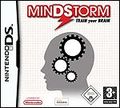You can trust VideoGamer. Our team of gaming experts spend hours testing and reviewing the latest games, to ensure you're reading the most comprehensive guide possible. Rest assured, all imagery and advice is unique and original. Check out how we test and review games here
Games started swatting up in around June 2006. It’s not really clear why, but suddenly a new wave of games that re-packaged ‘edutainment’ as good old entertainment suddenly became very popular indeed.
The pretence of games that improve your mind power were always going to be as popular with the press as with worried parents, and it all started with Prof. Kawashima’s Brain Training: How Old Is Your Brain?, which has spawned several off-shoots and clones.
One of the latest is MindStorm, which does a fairly bland job of making fine-tuning your brain into an enjoyable game. A limited selection of puzzles are available at different difficulty levels, which together purport to improve five areas of your brain: reason, endurance, analysis, intuition and observation.
As with any of this kind of game, the notion that MindStorm actually improves your brainpower in a scientifically quantifiable way is a dubious one. Playing through random selections of the puzzles fills bars, which represent one of each of the five intelligence categories. Filling a bar levels you up and adds one to your total ‘Brain Level’, which essentially feels like little more than a glorified hi-score as it is generally always raising, and never falls, even after repeated errors on your part. In just a couple of hours it is quite easy to achieve a ‘PHD-Type mind’, which casts yet more doubt over the weight to the game’s mind rating system.
The ten puzzle types on offer, which consist of classics like sliding block picture challenges and spot-the-difference, are mundanely presented and jump wildly from being patronisingly simple to mind-bogglingly hard. The rather dire graphics shine, however, in comparison with the infuriating stylus accuracy. All too often you can fail after a streak of Einstein-like puzzling because of a simple misreading of stylus positioning on behalf of the game, which is utterly frustrating and takes away any sense that MindStorm is making an accurate reading of your intellectual ability.
The impact of the unreliable stylus interaction is compounded further by puzzles that require you to rotate objects. Instead of making practical use of the shoulder buttons, a double tap of the touch screen is used, which is simply too easy to get wrong and too temperamental to rely on.
The puzzles also quickly become horribly repetitive and uninspiring, and extended play of MindStorm will only appeal to stubborn puzzle fans at best. However, played in small doses there is no doubting that it is enjoyable, and the characterisation of the professor who guides you through the game is wonderful and well scripted.
The nicest touch, however, comes in the form of the inspired Scene game mode, which tailors the game to suit your surroundings. As opposed to the Free mode, which lets you tackle puzzles by type, the Scene mode offers you choices such as ‘At Home’, ‘During Breaks’, and ‘In Transit’, and adapts the game style and length dependent on if you are squeezing in a game on the tube or relaxing at home for a longer session.
However, there are better ‘brain trainers’ available, and you can do a lot better than refining your grey matter with the distinctly average MindStorm.

/https://oimg.videogamer.com/images/62e9/mindstorm_5.jpg)






